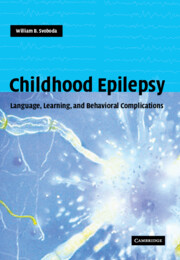Book contents
- Frontmatter
- Contents
- Preface
- Glossary
- 1 Looking ahead
- Part I Speech and language problems
- Part II Learning problems
- 12 Learning challenges
- 13 The development of learning
- 14 Learning difficulties
- 15 Learning problems with seizure types
- 16 Modifying factors
- 17 Transient cognitive impairments of epilepsy
- 18 Attention and alertness
- 19 Memory
- 20 Executive functioning
- 21 Academics
- 22 Antiepileptic medication effects
- 23 Effects of other therapies
- 24 Diagnosis
- 25 Gaining help
- 26 Frustrations of learning problems
- Part III Behavior problems
- Index
- References
22 - Antiepileptic medication effects
from Part II - Learning problems
Published online by Cambridge University Press: 26 October 2009
- Frontmatter
- Contents
- Preface
- Glossary
- 1 Looking ahead
- Part I Speech and language problems
- Part II Learning problems
- 12 Learning challenges
- 13 The development of learning
- 14 Learning difficulties
- 15 Learning problems with seizure types
- 16 Modifying factors
- 17 Transient cognitive impairments of epilepsy
- 18 Attention and alertness
- 19 Memory
- 20 Executive functioning
- 21 Academics
- 22 Antiepileptic medication effects
- 23 Effects of other therapies
- 24 Diagnosis
- 25 Gaining help
- 26 Frustrations of learning problems
- Part III Behavior problems
- Index
- References
Summary
In 1948, William Lennox observed: “Many physicians, attempting to extinguish seizures, only succeed in drowning the intellectual process of the patient.” The goal of therapy is to stop the seizures without stopping the patient's functioning. With antiepileptic medications, the question concerns not the best drug for the seizure type but rather the best drug for the child.
Anticonvulsants
The goal of modern drug treatment for epilepsy should be the cessation of seizures but also the prevention of cognitive and behavior dysfunctions (Billard, 1999). All anticonvulsant drugs impair cognitive functions to some degree, although some do so more than others. The longer a drug is in use, the longer becomes the list of side effects associated with it. No single drug causes problems in every patient. No drug can be assumed to never cause any cognitive impairment (Bourgeois, 2002). Adverse effects on learning and behavior usually appear by one month after beginning an antiepileptic medication (Henricksen, 1990). The effects of antiepileptic drugs on brain development and cognitive functioning need to be considered when choosing which antiepileptic to use (Alpherts & Aldenkamp, 1990; Blennow et al., 1990; Rugland, 1990; Trimble, 1990).
Adverse effects
Antiepileptic medications at excessive dosages impair both behavior and cognition, even if used alone (Matthews & Harley, 1975; Stores & Piran, 1978; Bourgeois et al., 1983; Reila, 1998). Although drug levels can be checked, the standard therapeutic ranges signify only a level needed and tolerated in many patients; there are exceptions.
- Type
- Chapter
- Information
- Childhood EpilepsyLanguage, Learning and Behavioural Complications, pp. 337 - 361Publisher: Cambridge University PressPrint publication year: 2004



